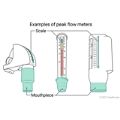Our Health Library information does not replace the advice of a doctor. Please be advised that this information is made available to assist our patients to learn more about their health. Our providers may not see and/or treat all topics found herein. A home lung function test uses a peak flow meter or a home spirometer to monitor and evaluate any breathing problems you may have on a day-to-day basis. A peak flow meter allows you to measure your peak expiratory flow. A home spirometer allows you to measure your forced expiratory volume at 1 second (FEV1). If you have a lung disease, such as asthma, your doctor may test your peak expiratory flow (PEF) to measure the amount of air you can inhale and quickly exhale. This is tracked to see how well asthma is managed. Testing your peak expiratory flow (PEF) or your forced expiratory volume at 1 second (FEV1) at home may help: To perform the peak expiratory flow (PEF) test, you need a peak flow meter. A peak flow meter is an inexpensive handheld device you breathe into as hard and as fast as you can. Read and follow the instructions included with the peak flow meter. Ask your doctor to show you how to use this device before you use it at home. If you have questions about how to use a peak flow meter or how to read the results, talk with your doctor. If you use medicine to help with breathing (such as for asthma), talk to your doctor to learn how long you should wait to test your lung function after taking your medicine. You may need to wait a few hours after taking the medicine to do the test. Or your doctor may recommend that you test your lung function in the morning before you take your medicine. Avoid eating a heavy meal before performing a PEF test. Be sure to sit up or stand up as straight as possible to help you take as large a breath as you can. Use the same position every time you test your PEF. Peak flow monitoring relies on your trying as hard as you can. For accurate results, be sure to give the test your best effort every time. Before you start, remove any gum or food you may have in your mouth. Be sure the gauge of the peak flow meter is set to 0 or the lowest number on the meter. Some meters don't have a separate mouthpiece. Keep your tongue away from the mouthpiece. A hard and fast breath usually makes a "huff" sound. This is your peak flow. Write down the highest of the three numbers in your asthma diary. If you cough or make a mistake during the testing, redo the test. Breathing in and out very quickly during these tests may make you feel lightheaded or may make you cough. If you feel like you are going to pass out, stop the test. There are no significant risks linked with measuring peak expiratory flow (PEF). Breathing in and out very quickly during the test may make you feel lightheaded or may make you cough. If you feel lightheaded, stop the test. Results from a peak flow meter or home spirometer can be compared to monitor the progression of disease or help measure your response to medical treatment for a long-term (chronic) lung disease, such as asthma. Peak expiratory flow, or peak flow, is how much air you breathe out when you try your hardest. You can help manage asthma by checking your peak flow and comparing it with your personal best measurement. If you find abnormal results on any of the tests, check your asthma action plan or discuss your results with your doctor. Current as of: July 31, 2024 Author: Ignite Healthwise, LLC Staff Current as of: July 31, 2024 Author: Ignite Healthwise, LLC Staff Clinical Review Board This information does not replace the advice of a doctor. Ignite Healthwise, LLC disclaims any warranty or liability for your use of this information. Your use of this information means that you agree to the Terms of Use and Privacy Policy. Learn how we develop our content. To learn more about Ignite Healthwise, LLC, visit webmdignite.com. © 2024-2025 Ignite Healthwise, LLC.Home Lung Function Test
Test Overview
Why It Is Done
How To Prepare
How It Is Done
How It Feels
Risks
Results
Related Information
Credits
Clinical Review Board
All Ignite Healthwise, LLC education is reviewed by a team that includes physicians, nurses, advanced practitioners, registered dieticians, and other healthcare professionals.
All Ignite Healthwise, LLC education is reviewed by a team that includes physicians, nurses, advanced practitioners, registered dieticians, and other healthcare professionals.
Our Health Library information does not replace the advice of a doctor. Please be advised that this information is made available to assist our patients to learn more about their health. Our providers may not see and/or treat all topics found herein. Current as of: July 31, 2024 Author: Ignite Healthwise, LLC Staff Clinical Review BoardHome Lung Function Test
All Ignite Healthwise, LLC education is reviewed by a team that includes physicians, nurses, advanced practitioners, registered dieticians, and other healthcare professionals.




